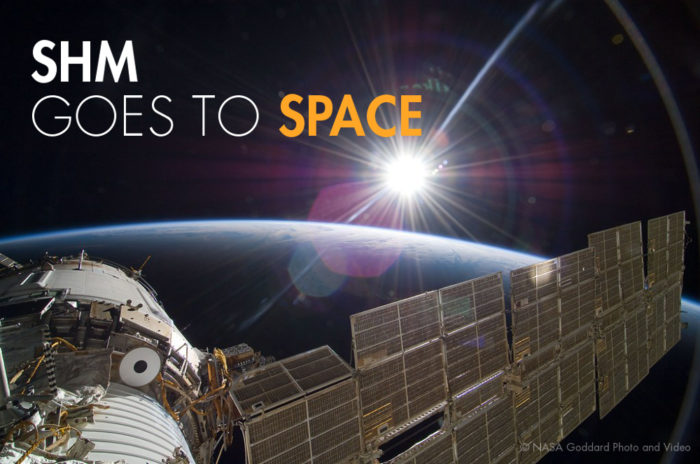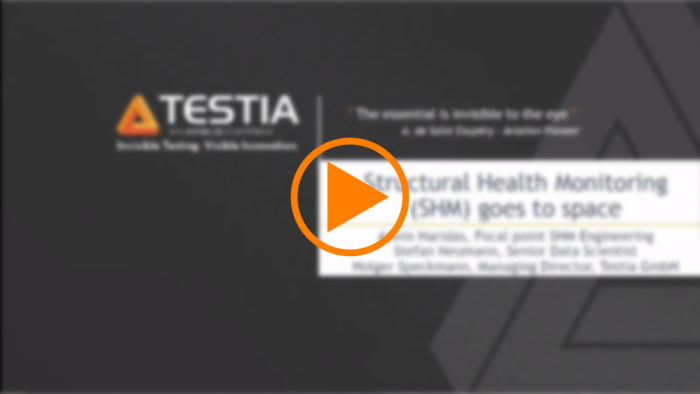Wie kann man Missionen ins Weltall mit kontinuierlicher Datenerhebung sicherer machen? – Structural Health Monitoring in der Raumfahrt! Aswin Haridas, SHM-Experte bei Testia, hat eininge Konzepte zu diesem Thema beim Munich Symposium on Lightweight Design vorgestellt, live per Zoom am 3. November 2020.
Die Nutzung von Structural Health Monitoring in der Raumfahrt ist eine relativ neue Innovation, somit bieten sich viele interessante Entwicklungen und Themen zur Diskussion an. Zum Beispiel: Welche Sensoren sind am besten geeignet sowohl für die Messaufgaben als auch für die Nutzung im Vakuum des Weltraums?
Unten finden Sie das Abstract und einen Video-Mitschnitt der Präsentation von Aswin Haridas (beides auf Englisch), inklusive ausführlichem Vergleich, wie geeignet verschiedene SHM-Sensoren zur Überwachung von Strukturen in der Raumfahrt sind.
Abstract der Präsentation:
Over the past few decades, there has been an increased interest in developing innovative solutions for exploring outer space, for space tourism or for unmanned or manned planetary explorations. To ensure improved levels of mission safety, reliability and affordability, several stakeholders including ESA and NASA have employed advanced technologies to monitor the health of mission critical structures. These newly developed asset monitoring systems are aimed to ensure high robustness and mission reliability.
Although the use of conventional Non-Destructive Testing (NDT) methods can provide sufficient information about the state of a given structure at any point in time, they fail to provide continuous streams of information about the structural health. Such a need has asserted the use of Structural Health Monitoring (SHM) sensors and technologies to continuously monitor the health of critical structures throughout the mission to increase their levels of safety and thereby, reducing the overall mission costs. Analogous to a human body, such sensor network would in essence imitate a human nervous system. By analysing the continuous stream of data from such a sensor network an effective prognosis and diagnosis of the state of the critical structure can be made.
Some of the most commonly used SHM techniques include conventional strain gauges, fiber optic sensors and acoustic sensing techniques, among many others [1]. Since the fundamental working principles of each of these technologies are different, their performance is strongly dependent on the use-cases. In the case of Structural Health Monitoring for space vehicles, especially for the measurement of large pressure vessels located at critical section of a space launch vehicle, adequate studies for sensor selection must also include the assessment of the environmental conditions and the measurement range & accuracy of the sensors.
Apart from choosing the sensors that fit the requirements, be it for monitoring operational parameters (e.g. strains and temperatures) or for monitoring the formation and propogation of damages (e.g. delamination), its dependence on the ambient conditions (e.g. ambient temperatures vacuum, cosmic radiation and electromagnetic emissions) must also be evaluated. Even though several studies have investigated the performance of SHM technologies in space environments, most of them do not compare the capabilities of different techniques, especially for monitoring the pressure vessels used in space launch vehicles [2].
Furthermore, since the use of SHM in monitoring space assets is a relatively new innovation, there exists the need for developing standards in order to define the minimum requirements and for validating and certifying the performance of such sensor networks. Such a standard is currently non-existent. In this context, we investigate the most commonly used SHM technologies and compare their performance (for space applications) based on a set of requirements derived from several factors including, environmental conditions, measurement reliability and the technology maturity. In addition, comments on the development of suitable standards and performance evaluation methodologies would be made.
References:
[1] H. Speckmann, R. Henrich, Structural health monitoring (SHM)–overview on technologies under development, In Proc. of the World Conference on NDT, Montreal-Canada, (2004).[2] M. Simone, G. Tumino, P. Gaudenzi. „Structural health monitoring for future space vehicles.“ Journal of intelligent material systems and structures 17, no. 7 (2006): 577-585.Für mehr Inforamtionen über Testias SHM-Services oder um uns zu kontaktieren, klicken Sie auf folgende Links:


